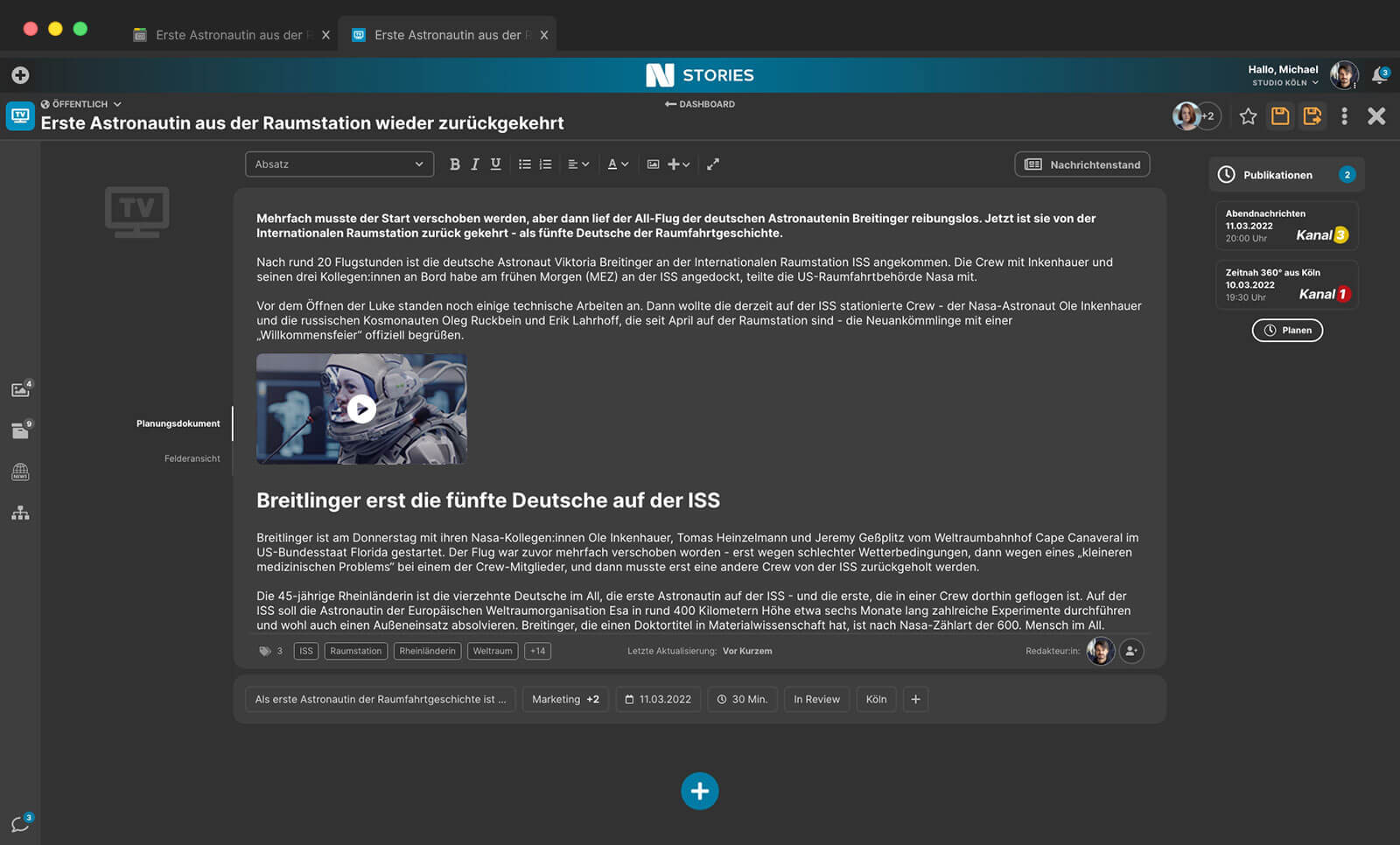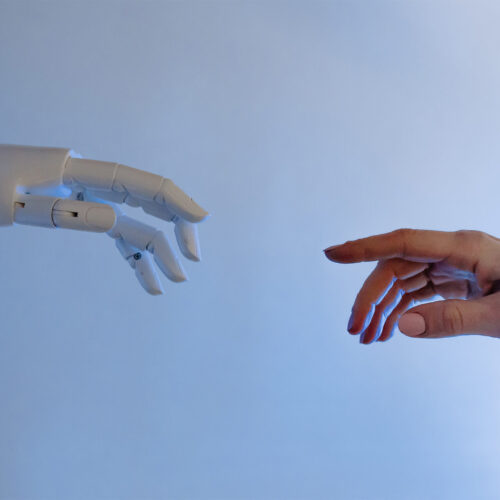What is a newsroom? By its very definition, a newsroom is the place or desk where journalistic editorial teams of media companies sift through story alerts, topics and news reports, manage content and plan publications. This was portrayed idealistically by “The Newsroom”, a TV series about a fictional cable news network: Journalists want to create accurate and good news for their audiences and put together a news broadcast. Today, the term newsroom, often also called newsdesk, does not only stand for a central workplace. In a broader sense, the newsroom concept also describes interdisciplinary collaboration in editorial departments – moving away from separate desks. The goal is to be more efficient: After all, newsrooms must not only be measured by the quality of their content, but also by their economic efficiency – to which the newsroom model makes a significant contribution. The newsroom concept is therefore not only used in the context of traditional broadcast newsrooms, but also by companies (corporate newsroom or pressrooms).
Content of this page
Newsroom definition: Collaboration on multimedia news production
A newsroom is the communications center of editorial departments of a newspaper, radio station, or TV station as well as multimedia companies. In the journalistic environment, the newsroom definition means two things at once: One is the editorial location where news stories and current reports and topics are received. And second, the newsroom or newsdesk is where senior editors from different departments come together to discuss topics and plan the distribution of the corresponding content across channels. This can be on site at a real desk or in a digital newsroom with the help of suitable newsroom software.
This type of collaborative teamwork often transcends editorial boundaries and breaks down silos: The aim of a newsroom is to react quickly and work in a resource-efficient manner. Particularly in large media companies that include video and audio in their portfolio alongside print and online media, editorial representatives from different channels and offerings meet in the newsroom – in the spirit of cross-media content strategy and marketing.
Today, the concept of the newsroom applies not only to broadcasters and the media, but also to companies. Online newsrooms are becoming the basis for corporate communications.
How does a newsroom work?
When media companies set up a newsroom concept, they bring together many different departments and areas of responsibility. The goal is to approach topics in a media-neutral way. Individual editorial departments and silos are broken down to create a central, cross-media control unit. Topics are planned jointly under the coordination of a chief of staff or editorial team and only then prepared for different channels or formats. The result: more efficient media production. This applies to broadcasters just as much as to the corporate newsroom model.
From newsdesk to online newsrooms
The newsroom concept is a U.S. achievement of the 1990s. The daily newspaper “The Philadelphia Inquirer” is said to have set up the first modern newsroom in 1994. Following this successful example, more and more editorial offices of newspapers developed and implemented their own newsroom concept. Since then, more and more newsrooms have abandoned the previously common practice of strictly separating individual departments in their day-to-day editorial work. A major driver of this change is the advancing digitization and the associated demand to utilize content multiple times in order to increase the efficiency and cost-effectiveness of content distribution. This is accompanied by a revolutionary change in the way many editorial teams work: away from thinking and acting in terms of departments and specialist responsibilities, and toward a cross-media focus on topics and their collaborative preparation.
In practice, this means that while in analogue times there were organizationally separate and independently operating editorial teams for the classic publication channels of print, radio and television, today it’s all about delivering target group-specific content, for example as articles, videos, audio contributions or infographics, at the appropriate touchpoint – from printed newspapers and magazines to websites, news portals and social media. This means that in a newsroom concept, the focus is no longer on the distribution channel, but on the editorial content itself. A fundamental paradigm shift.
Multimedia Newsroom - Status quo in newsrooms and companies
Around the world, editorial departments in newspapers or TV have implemented new types of newsroom concepts: from a new newsroom strategy at the NY Times to German public broadcasters like WDR and NDR, that also rely on cross-departmental concepts according to the newsroom definition in order to better shift to digital and link TV, online and mobile. The principle of working together on larger issues in an online newsroom has been gaining ground in more and more companies and corporations for some time now – and the keyword here is integrated communication. The aim is to disseminate consistent messages in all channels and at all touchpoints and closing the gap between old ways and the digital future.
Why an Online Newsroom is a driver for success
In the battle for market share and against the superiority of Big Tech companies like Meta, Google and Apple, which are also gaining an ever stronger foothold in journalism, editorial offices and media companies can no longer ignore newsroom concepts. Here, too, efficiency and agility are key. In order for editors to be able to work together across departments and on multiple channels, one essential requirement must be met: a digital newsroom is needed. Because the many established sources of information such as
- News Agencies,
- research networks,
- press representatives,
- government agencies,
- personal contacts and
- own investigations

have now been joined by social networks. In just one minute, there are 350,000 tweets, 65,000 photo uploads and 350,000 scrolls on Instagram, more than 400 hours of new video footage on YouTube and 3.8 million searches on Google. Against this backdrop, newsroom staff are being challenged to constantly monitor digital information channels such as news and
event portals and social media, filtering out what is relevant and incorporating it into their own topic planning. In view of the volume of information, it is clear that this research and monitoring task cannot possibly be carried out manually, even in the largest newsroom. This is where digital newsrooms supported by artificial intelligence come into play.
Online newsrooms and AI – Use Cases
When it comes to digital information, artificial intelligence such as that used by newsroom system Newsmind Stories can monitor countless streams and filter incoming messages – from news tickers to the websites of media companies and X feeds. It also structures new alerts as well as posts and groups them into topic clusters. In this way, an AI automates many processes of cross-media topic planning and distribution in the newsroom.
To do this, the AI analyzes incoming news with regard to characteristics such as people, places, institutions and facts, calculates the proximity of topics in terms of content and presents similar reports in a clearly arranged manner. In this way, editors in the newsroom not only gain a good overview of the current topic and news situation, they can also plan and create cross-media contributions and implement them in a media-specific way.


An online newsroom and planning tool shows which colleague in the newsroom is working on which issue. This enables media companies to make better use of their employees’ resources: Editors in the newsroom either work together on a complex set of topics or devote themselves to completely different topics.
With an artificial intelligence integrated into a newsroom system, the tool analyzes similar news from the competition and generates customizable streams from selected Twitter feeds that update in real time. In this way, editors in the newsroom receive an up-to-date overview of the latest publications within their peer group when preparing a topic. They not only know which medium is focusing on which aspects, but also which topics are currently trending in which channel and in which regional or local environment. In this way, they can set themselves apart from the competition with their own contribution, approach a topic from a different perspective, or take it further in terms of content.


Editors and newsrooms can search the archive material with the help of AI, for example for previous publications as well as for suitable image, video and audio material. Based on a keyword, the AI plays out suitable suggestions within a few milliseconds by analyzing the automatically extracted metadata with regard to their similarity to the search term. In this way, editors gain an overview of a topic and can refer to or link to older articles in a new article.
WANT TO LEARN MORE ABOUT NEWSMIND STORIES?
Schedule a personal talk with Jochen – for free and no strings attached.
Benefits of the newsroom concept
In combination with AI-supported newsroom software, a newsroom concept opens up a range of strategic and practical advantages.
and practical advantages. It is…
- …more efficient, because editors no longer work simultaneously on identical topics.
- …of higher journalistic quality, because teams from different departments work on complex topics in an interdisciplinary manner.
- …integrated, because editorial teams plan and edit topics across platforms and media.
- …faster, because editors can always keep an eye on the news situation thanks to a planning tool and can publish prepared content at the click of a mouse.
- …digital, because a planning tool supports content distribution to various digital touchpoints.
- …high reach, because a topic can be published across all channels.
Digital newsroom in the field
Under the name Plan.R, the German public broadcaster Westdeutscher Rundfunk has successfully introduced our Newsmind Stories software: an AI-supported editorial system. Using a virtual Kanban board, WDR employees can plan cross-media topics across editorial teams and play out articles in the desired publication medium at the right time.
Success Story EN
Get the WDR story sent to you now:
Newsroom definition – our conclusion
The newsroom concept is an adequate solution to cope with the complexity of increasingly digital communication. In order to reach their own readership in the future, editorial teams must not (any longer) focus on a single channel. Instead, they must deliver target group and channel-specific content in the appropriate format (text, audio, video, etc.) at those touchpoints where they meet their customers – be it in a print magazine, on its digital counterpart, or in social media. Under the premise that editorial offices and media companies use appropriate software, a newsroom is the ideal prerequisite for making editorial processes more agile and efficient – today and in the future.
More interesting articles that you shouldn’t miss





